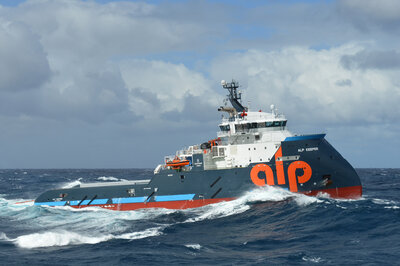
ALP Keeper (Boka Keeper)
New name: Boka Keeper. Ultra-long towing distance, oceangoing tug. With a bollard pull of approx. 300 t, the vessel is designed for towing very large structures over long distances, such as oil rigs or FPSOs from the building yards to the installation site at the oil field. The vessel has fuel capacity to tow at full power for 45 days.
Primary specifications as built
Additional Data
Ship history
The ALP Future-class vessels of the SX157 design were developed in close collaboration with ALP Maritime. The vessels are outfitted with DPII and anchor handling capacity in order to assist during the installation/hook-up phase for the towed objects.
When developing the design, Ulstein had to ensure that each vessel had the sufficient bollard pull and operational reliability to handle even the heaviest tows with only two vessels. Environment and fuel efficiency have also been important criteria. The vessels are classed with DNV's Clean Design and Ice Class 1B notations, which allow operation also in restricted zones. Additionally, they are equipped as anchor handling vessels including stern roller, a three-drummed winch with 400t hoisting capacity, and with chain lockers for rig chain. The ships have comfortable and spacious accommodation reflecting long periods at sea.
These vessels have a fuel capacity of 3400 m3 of IFO/MGO sufficient for non-stop Trans-Atlantic/Indian and Pacific Ocean towing operations without fuel calls. These long-distance towing vessels have a bollard pull of 300+ tonnes, a service speed of 13 knots and a top speed of over 19 knots. The DP2 dynamic positioning capability allows ultra-long distance towing, offshore installation and decommissioning of large floating production, storage and offloading (FPSO) units, floating liquefied natural gas (FLNG) units and floating drill rigs at the highest safety levels.
Ulstein, in addition to providing the design, was also responsible for the deliveries of main components, such as engines, thrusters and propellers, winch, power distribution and thruster drives, control system and communication system.
2018 update:
Extract from an article in Offshore Support Journal:
Of the recent newbuilding deliveries, those operated by ALP Maritime Service have the greatest bollard pull. The main propulsion and deck machinery (in the ALP Future-class vessels) can undertake all types of offshore structure towage, including some of the world's heaviest floating production systems. The DP2 class and the high bollard-pull capabilities of these vessels were key elements in their conception and design.
"With Ulstein, we designed a vessel that combined all the primary features of anchor-handling tug, supply and towage vessels that were expected by our clients."
ALP Maritime CEO Paul Mulder
Mr Mulder noted that the ALP Future class offer a full vessel-spread solution to its clients, while the DP2 system results in increased redundancy of systems during towage.
"Having DP2 on these vessels assists positioning operations and reduces the likelihood of major vessel breakdowns, which is a valuable aspect when towing multi-billion dollar structures across the world's oceans", said Mr Mulder.
ALP's fleet has now completed many projects involving the towage and positioning of floating production storage and offloading (FPSO) vessels from shipyards to offshore oilfields. Its Future class of vessels towed the Kaombo Norte FPSO from Singapore to Angola in a spread during Q2. Once this spread reached Angola, three more ALP vessels were brought in to assist in stationing Kaombo Norte and securing its mooring lines. On completion of the mooring activities, two of the vessels continued to support the riser pull-in operation.
Vessel overview
- Boka Striker (ALP Striker) - delivered September 2016 - IMO Number: 9737230
- Boka Defender (ALP Defender) - delivered June 2017 - IMO Number: 9737242
- Boka Sweeper (ALP Sweeper) - delivered October 2017 - IMO Number: 9737254
- Boka Keeper (ALP Keeper) - delivered February 2018 - IMO Number: 9737266
Nov. 2024: Boskalis Offshore Long Dist. is new owner and operator and the vessel have changed name to Boka Keeper.